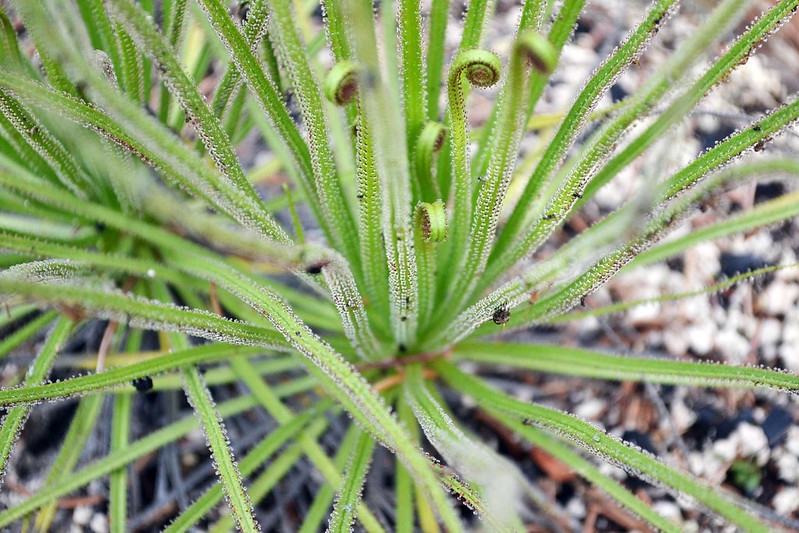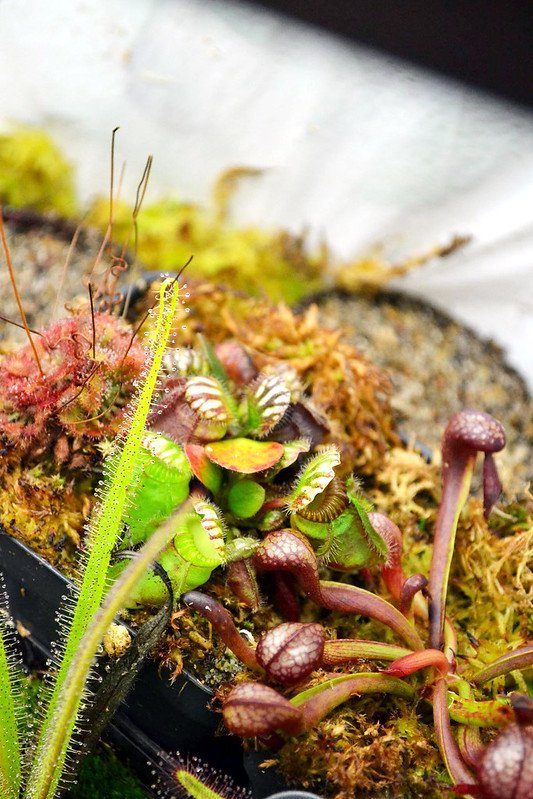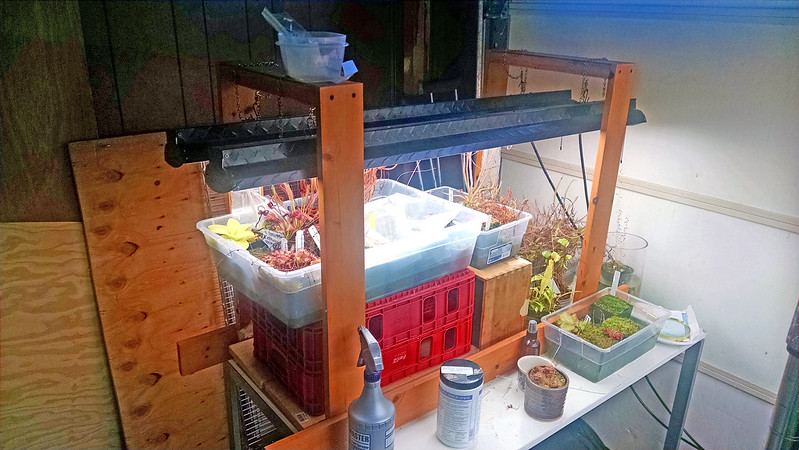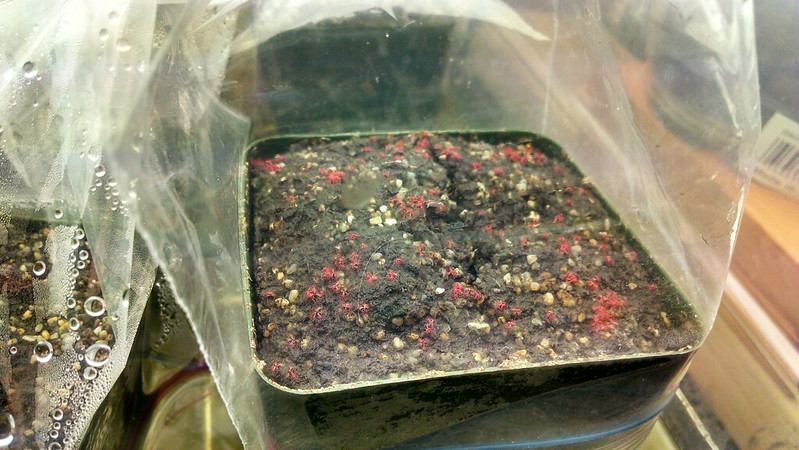This is part of a series of conversations with other growers about their experiences
growing carnivorous plants. It's always useful to see how someone else
does things! The full series can be read here, or by grower at the Series page.
David Flocken is a sundew grower and
Drosera capensis enthusiast living in Utah. We've chatted about plants on Facebook and elsewhere, so we decided to do a Grower Interview for the blog, the first in a while. Hopefully we'll get back to doing these a bit more regularly!
Sundews Etc. So Dave, thanks for sitting down for an interview.
SE I'm glad we could finally work out the logistics!
David Flocken No problem, thanks for having me I'm pretty excited.
DF And yeah we were all over the place there for a minute.
SE We first chatted on
TerraForums a bit ago about
Drosera capensis, why don't you talk about what you're doing with that species right off the bat.
DF The first thing I'd like to say about the species
Drosera capensis is that it's one of the most overlooked species in the hobby. However, to me, the plant continues to
interest me all these years later.
SE It's a wonderful plant.
DF Drosera capensis, in its many growth forms, varieties, unofficial cultivars has a very
Dionaea-esque feel. Right now I'm trying to acquire as many types as possible,
but have been particularly enamored with a recently discovered variety "Big Pink."
 |
| D. capensis "Big Pink" as grown by David Flocken. |
SE That's a hybrid of the 'Albino' cultivar with the red form, right?
DF Yes, that's the conclusion a few growers and myself have come to, though it's not completely confirmed. We'll have to sort that out with manual and purposeful hybridizing of
capensis 'Albino' and the "All red" plants – presumably all true red forms originate from Gifberg South Africa.
DF And the "Alba" is a variety which occurred and only occurs in cultivation.
SE I've been researching the all-red variety and yes, all the full-red plants in cultivation come from Gifberg, and were collected by Eric Green.
DF "Big Pink" differs from "Red" in it's growth rate and a lowered ability to produce anthocyanin in the leaves, this causes a blotchy or oftentimes "pink" coloration.
SE That sounds pretty cool. How many different forms of
D. capensis are you growing currently?
DF Currently I'm growing "Wideleaf", "Bainskloof", "Alba", "Typical", "Narrowleaf", "Big Pink", and "Red" but at least 10 more varieties are sitting idle as seed in my fridge,
along with many, many thousands of typical seeds.
SE Cool. What sort of goal do you have in mind with this research, if any?
DF Well for one, I hope to describe and officially differentiate the many unofficial statuses of these plants. Glean a new variety from typical seeds (just through brute force
of growing many and looking for good traits)
DF I hope to make interesting crosses, one I'm working on right now is "Big Pink"x"Wideleaf" using two of my most beautiful specimen plants.
SE That sounds like a lot of fun.
SE What's your growing setup like?
DF Well I have my outdoor grow which rests idly in dormancy in our unheated garage, whilst my indoor setup is downstairs; which I primarily use to grow
Drosera and
Cephalotus.
DF We have a cool basement, which I use to my advantage. The grow chambers can get rather hot as they are essentially 4 foot t8 lights resting over various plastic and glass
terrariums.
DF I use reflective material like mylar and tinfoil to keep in the light, but nothing too special.
 |
| The Cephalotus grow tank. |
SE I think cool temperatures are often overlooked as a factor for lots of sundews.
SE There are lots that don't appreciate it hot, especially at night.
DF I agree, I've noted this in species like capensis, regia, adelae, spatulata. In fact there isn't a single species I can think of aside from burmanii maybe that doesn't dew
up more, or color up more, from lower nighttime temperatures.
DF Across the board carnivorous plants seem to benefit from a cooler resting period.
DF What about your pygmys? Do they need that temperature drop? I've always wondered about those guys.
SE They definitely don't mind it. Certainly if we have a prolonged hot spell there are species that go dormant.
SE Although I live in the inner Bay Area, so I basically have a tropical highland climate, which is almost cheating for carnivorous plants.
SE Always cool, but almost never down near freezing at night.
DF That's quite the contrast to where I live. We're what you call an arid sub-tundra desert. Right now it's 20 degrees outside, and dropping.
DF Which leaves me incapable of growing almost any sundew outside in a non-bog environment.
SE Yeah that would complicate my growing situation significantly, hahah.
SE When did you get started growing carnivores?
DF Growing up I was always that kid, or that family rather, with the snake or the tarantula. Always looking for that novelty plant at the convenience store.
SE Oh, so your family is in to similar stuff.
SE That must be nice.
DF Oh yeah, despite their groans and occasional complaints my family has been extremely supportive throughout my growing career. My dad even gets involved in the building
projects from time to time.
DF I must have been around 12 or 13 when I first emailed "Sundewman" seeking out help to not kill my lowly
Drosera spatulata.
SE Oh man, Aaron May. What a hero.
His site is what got me started too.
DF I agree, shout out to Aaron. He's been the reason more than once I was able to re-enter the hobby.
SE So you're a sundew guy, like Aaron and I then.
DF Oh yeah, while interning at
Meadowview Biological Research Station, Phil often called me a "Dew-head" always looking for his "Dew-fix" often seeking out his "Daily-dew" and
many others I'll not say here.
SE Hahahahah that's great.
DF And honestly, those little globular beads at the end of those tentacles have gotten me through a lot. They certainly speak to simpler times when I was just starting out in
high school.
SE How was interning at Meadowview? That must have been awesome for a carnivorous plant enthusiast.
 |
| Dave in Virginia, looking at a clump of Drosera capillaris (not pictured). |
DF Meadowview was a fantastic opportunity, I worked at the site called Joseph Pines in Northern Virginia. I did restoration work relating to Longleaf pine, and their associated
habitats. So I saw some amazing Sarracenia and bog habitat while I was there.
DF If you're ever in Virginia, both Meadowview's nursery in Fredericksburg and Jospeh Pine's preserve in Disputanta are a must-see.
SE I'd love to visit.
SE A trip to the southeast is definitely on my radar in the next few years.
SE What plants do you grow besides your
D. capensis collection?
DF Well after Meadowview, I've become invariably hooked on
Sarracenia, particularly flava, give me anything flava. I have a sizable collection of
Cephalotus, a few hundred
venus flytraps (sigh), and my most recent obsession of germinating and raising
Drosophyllum.
DF Along with many other South African sundews, I feel capensis is the staple of my collection.
SE Hahah oh man. That sounds like a lot of plants. How much time do you spend with them in a given week?
DF I'd say they get about 4 hours of truly useful care during the week, and seemingly endless (probably 15 overall) of endless tinkering.
SE You feed your sundews, right? What do you use?
DF I have an obsession with feeding my sundews. Sometimes I think the plants secretly hate me for it. I feed them ground freeze dried blood worms.
SE Do you rehydrate them or grind them, or just apply as-is?
DF In the morning I go into the basement and begin feeding. I use the grow lights to wake myself up in the morning and treat a little bit of seasonal depression.
DF I tried rehydrating for a while, but that was too much work for the amount of feeding I did.
DF Then I tried grinding the food and mixing it with water in pipettes which also took too long.
SE One must always weigh how useful something is against how likely they are to actually do it.
DF So now I just grind it up in my palms, and dust it onto the leaves seems to be the fastest method for me if you account the food preparation time.
DF Unfortunately I've developed a death-like allergy to the stuff.
SE Oh no!
DF The things we do for our plants am I right?
SE Absolutely.
DF Regarding the large amount of feeding, I've noticed a huge amount of growth and speedy development.
DF So it's not all crazy (I hope).
SE Yeah, feeding is a huge factor I've noticed.
SE How much does your collection cost you on a monthly basis?
DF It's hard to say without accounting for things like energy costs from the lights and mental strain on my family, but I'd say at least 40-50$ a month.
DF Luckily I can counteract that with small time seed and plant sales.
 |
| Using sewing string to mark the cross-pollinated flower. |
SE Yeah that's the good move.
SE Make it all equal out.
SE Are there any carnivorous plant societies in your area?
DF Ah, I knew we'd get to this, and sadly no there are none.
DF You'd be hard pressed to find any Utah growers unfortunately.
SE That's too bad.
SE You should take some of your extra flytraps and
D. capensis to like farmers' markets and try and entrap people.
DF Not a bad idea, who knows what will come of it in the coming years.
SE Well, at least there are forums and Facebook and all that.
DF I'm glad you mentioned that since forums and online sharing were my upbringing in this hobby.
SE We're very fortunate to have the online resources that we do. It makes it a lot easier to get into the hobby and get better at it.
DF Yeah, I didn't believe you could grow anything outside in my climate until I consulted the forums. It turns out a desert is just fine for many species like
Drosophyllum.
SE So you have good success with Drosos then? I've been meaning to try that plant.
DF Being a dew-head,
Drosophyllum is a most wondrous plant indeed.
DF And so tolerant of the dry and high-altitude conditions here. Even in the dead of summer they're plugging away.
 |
| Drosophyllum doing very well in Utah. |
SE That's awesome. I should give that one a try. I keep putting it off.
SE Do you have any big goals for your collection in the next year or so?
DF I'm hoping to work on the space and logistics of my collection coming up. Adding new setups before acquiring new plants has been a challenge I mean to tackle this coming
season.
SE Are you going to donate any seeds during the
ICPS Holiday Seed Drive?
DF Yeah, along with my annual giveaway of
Drosera indica seeds, I hope to send them a couple thousand. Hopefully they don't have too many at the moment.
SE It never hurts to donate! I'll be rounding up a lot of my seed as well.
DF Sounds like you already have the burmanii covered? I'll have to round up some capensis seeds as well!
SE Send whatever you can spare I reckon!
SE Finally, before I let you go, I seem to remember that there was talk of you starting a blog sometime in the near future...
DF Oh, the blog! Your site,
growsundews.com and the
Carnivore Girl have all got me excited about making my own blog.
DF Something that looks really nice where I can post and keep track of my random plant activities.
SE You should do it, blogging is great.
SE It's great to be able to search your old posts and look through your old pictures.
DF Oh yeah, I feel it's a better place for that than forums. And like your site it's a great place to get some attention towards sales and trades. I'm sure your blog has
accelerated your hobby to new levels.
DF I hope to do the same with mine which will be called "Dave's Dews."
SE It certainly makes me keep trying new stuff and documenting it!
SE Awesome, let me know if/when that gets started, and I'll share it on the blog.
DF Thank you I certainly will. I expect it will be up an running by this coming year 2016.
SE Great.
SE Thanks for doing an interview! Any last words of wisdom for fellow growers?
DF Thanks so much for having me!
DF To the CP community I'd just say I love you guys, a lot of you don't know it but you've helped me through so much. I also hope you'll all join me in the quest (shenanigans?)
to revive
Drosera capensis to the status it deserves
.
SE Amen to that. Thanks Dave.
 |
| Nice mix of species in Dave's indoor growing area. |



























